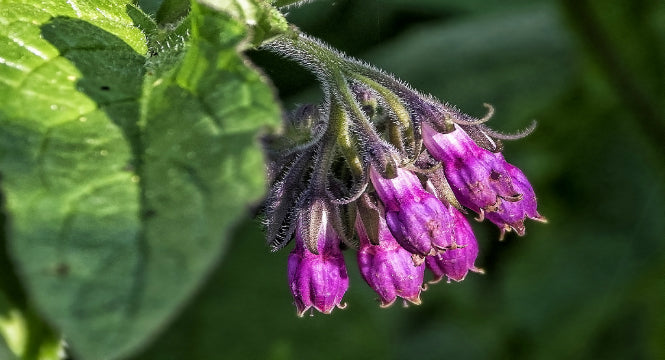Your Cart is Empty
FREE SHIPPING on US orders over $45. Save 25% With Code TAKE25 at checkout.
FREE SHIPPING on US orders over $45. Save 25% With Code TAKE25 at checkout.

Curious about allantoin and its role in anti-aging? If your skin is dry, flaky, scaly, sensitive or prone to wrinkles, you will want to look for products with this ingredient!
Discovered by a group of British scientists in the early 1900s, allantoin is found organically in comfrey herb (pictured), sugar beets, aloe vera, chamomile, and also in produced naturally in some mammals. It’s added to wrinkle creams, serums, lotions, body washes, and shampoos.
Allantoin is non-irritating and even healing. While some skin products can be harsh, allantoin is calming and soothing, which is especially good if you’re prone to rashes, redness, irritations, or scarring.
Although not technically a vitamin, allantoin is sourced from some of the most nutrient-rich foods around, so there is transference of vitamins, minerals, antioxidants, and anti-inflammatories.
Skin experts often see antioxidants as anti-aging warriors, fighting free radicals that cause disease and premature aging. Think of free radicals as “human rust.” Antioxidants are found in fruits and vegetables with names you’re used to hearing, such as vitamin C, vitamin E or beta-carotene. We can eat them, take them in supplements, or apply them topically.
Antioxidants keep us youthful, vibrant, and healthy. The presence of antioxidants in your diet and in your skincare routine will always show in your skin.
Allantoin occurs naturally, but to satisfy market need it’s is also available in “lab-form” for inclusion in skin creams. According to the International Journal of Toxicology, this version of allantoin is strong in similarity to its natural form, being non-toxic and with minimal side effects. To understand that concept, just think of the vitamins on the drug store shelf: some of the best supplements come from test tubes, but they are powerful mimics of the vitamins found in nature.
If your medicine cabinets are full of natural remedies for pain, inflammation, and wound-healing, then you’ve heard of comfrey.
Comfrey (Symphytum officinale) is a shrub found in Europe and some parts of Asia and has been used since Roman times because of its medicinal properties. It is important to note, though, that in 2017 it became banned for internal use by the United States and parts of Europe because of a possible linkage to liver damage.
However, it is considered completely safe for topical application. Comfrey extract is made from its roots and leaves and is turned into ointments, creams, or salves for the skin, with a content typically of five to 20 percent.
Comfrey is also considered to be an anti-aging superhero, because it contains both allantoin and rosmarinic acid. While allantoin promotes the growth of new skin cells, rosmarinic acid acts as the painkiller and reduces inflammation. Comfrey softens skin and reduces the appearance of fine lines and wrinkles, so when allantoin is included in skin creams you look fresh, radiant and ageless.
According to the University of Maryland Medical Center, comfrey is sometimes used on the skin to treat closed wounds and to reduce pain and inflammation from sprains, broken bones and joint pain.
Remember that pain, lesions, and poor health reflect in our faces, and the skin is our body’s largest organ. Beauty comes from both within and without, and if you are in pain, comfrey and allantoin are ingredients that you can be using topically to promote healing!
According to a research review published in Complementary Therapies in Medicine there is evidence that comfrey can help heal abrasion wounds. The same research review suggests that comfrey can help treat osteoarthritis and ankle sprains. Another study suggests that creams containing comfrey root can help relieve back pain.
Other possible sources of allantoin include:
Dry, parched skin is one of the major signs of aging, but it can also amplify fine lines, wrinkles, dullness and sagging. Dry skin doesn’t actually cause wrinkles, but wrinkles look more exaggerated on dry skin. This is why people with oily skin often give the appearance of having fewer wrinkles, the built-in moisture of that skin type gives it the appearance of being wrinkle-free.
Allantoin is also a gentle exfoliator, so it sloughs off dead skin cells, resulting in healthy tissue formation and a general brightening of the complexion.
So we’ve discovered that allantoin doesn’t just play a tiny role in anti-aging, allantoin is an anti-aging superhero! Filled with vitamins, minerals, antioxidants, and anti-inflammatories, allantoin brings so many benefits to any skincare product.